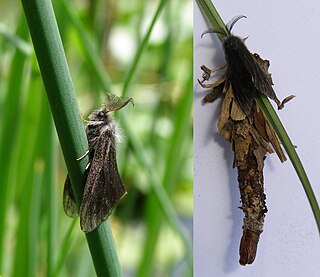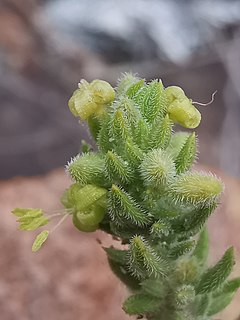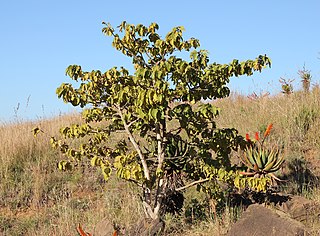
The Rubiaceae are a family of flowering plants, commonly known as the coffee, madder, or bedstraw family. It consists of terrestrial trees, shrubs, lianas, or herbs that are recognizable by simple, opposite leaves with interpetiolar stipules and sympetalous actinomorphic flowers. The family contains about 13,500 species in about 620 genera, which makes it the fourth-largest angiosperm family. Rubiaceae has a cosmopolitan distribution; however, the largest species diversity is concentrated in the tropics and subtropics. Economically important genera include Coffea, the source of coffee, Cinchona, the source of the antimalarial alkaloid quinine, some dye plants, and ornamental cultivars.

Tamarind is a leguminous tree bearing edible fruit that is probably indigenous to tropical Africa. The genus Tamarindus is monotypic, meaning that it contains only this species. It belongs to the family Fabaceae.

Xanthocercis is a tree genus in the family Fabaceae. Species include:

Canephora is a genus of flowering plants in the family Rubiaceae, indigenous to Madagascar.

Talinum paniculatum is a succulent subshrub in the family Talinaceae that is native to much of North and South America, and the Caribbean countries. It is commonly known as fameflower, Jewels-of-Opar, or pink baby's-breath.

Galium boreale or northern bedstraw is a perennial plant species of the Rubiaceae family. It is widespread over the temperate and subarctic regions of Europe, Asia and North America including most of Canada and the northern United States.

Anthospermum is a genus of flowering plants in the family Rubiaceae. It is found in Tropical and Southern Africa, Madagascar and in southwestern Arabian Peninsula.
Robynsia is a monotypic genus of flowering plants in the family Rubiaceae. It was described by John Hutchinson and was named after his friend and colleague Walter Robyns. The genus contains only one species, Robynsia glabrata, which is found in Ghana, Ivory Coast and Nigeria. The species is morphologically similar to the genus Cuviera but differs by having long, slender corolla tubes.
Vangueria schliebenii is a species of flowering plant in the family Rubiaceae. It is endemic to Tanzania.
Tapiphyllum was a genus of flowering plants in the family Rubiaceae but is no longer recognized. In 2005, a molecular phylogenetic study showed that the type species, Tapiphyllum cinerascens, is more closely related to Vangueria than to Tapiphyllum obtusifolium and Tapiphyllum velutinum. It is not clear whether the latter two species are really separate from Vangueria. All the species of Tapiphyllum have been sunk into synonymy with Vangueria.

Vangueria is a genus of flowering plants in the family Rubiaceae. The genus is named for Voa vanguer, as V. madagascariensis is known in Malagasy.

Vangueria infausta, the medlar or African medlar, is a species of plant in the family Rubiaceae, which is native to the southern and eastern Afrotropics. Some other names for V. infausta in Southern African languages include mmilo in Northern Sotho, muzwilu in Venḓa, umviyo in Southern Ndebele, mothwani in Tswana and umtulwa in Zulu.

Vanguerieae is a tribe of flowering plants in the family Rubiaceae and contains about 655 species in 30 genera. It is one of the most species-rich groups within the family and it is distributed all over the Paleotropics.

Fadogia is a genus of flowering plants in the family Rubiaceae. The genera Rytigynia and Fadogia form a strongly supported clade but neither of these genera is monophyletic.
Ancylanthos was a genus of flowering plants in the family Rubiaceae but is no longer recognized. It was originally described by René Louiche Desfontaines in 1818. In 2005, it was sunk into synonymy with Vangueria, based on a phylogenetic study of DNA sequences.
Cuviera is a genus of flowering plants in the family Rubiaceae native to tropical Africa. It was originally described by Augustin Pyramus de Candolle in 1807 and is named after the French naturalist Georges Cuvier.
Dondisia was a genus of flowering plants in the family Rubiaceae but is no longer recognized. It has been sunk into synonymy with Canthium. It was originally described by Augustin Pyramus de Candolle in 1830.
Vangueria venosa is a species of flowering plant in the family Rubiaceae. It is found in Mozambique, Eswatini and the former Transvaal region.

Vangueria pygmaea is a species of flowering plant in the family Rubiaceae.
Chapelieria is a monotypic genus of flowering plants in the family Rubiaceae. The genus contains only one species, viz. Chapelieria madagascariensis, which is endemic to Madagascar.












